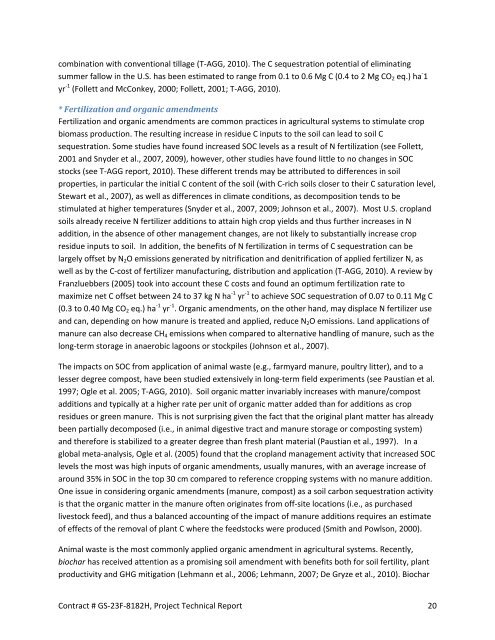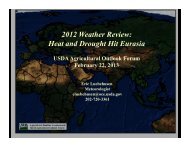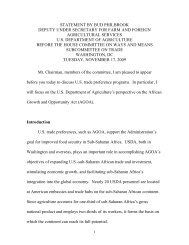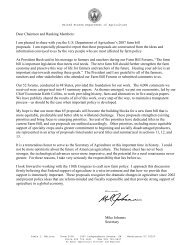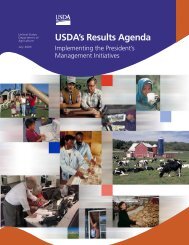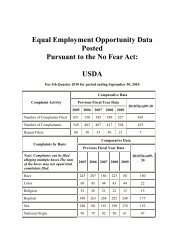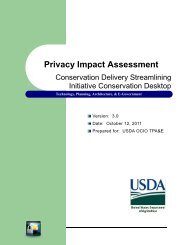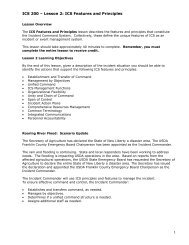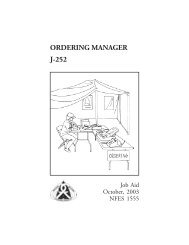Greenhouse Gas Emissions from U.S. Agriculture and Forestry: A ...
Greenhouse Gas Emissions from U.S. Agriculture and Forestry: A ...
Greenhouse Gas Emissions from U.S. Agriculture and Forestry: A ...
You also want an ePaper? Increase the reach of your titles
YUMPU automatically turns print PDFs into web optimized ePapers that Google loves.
combination with conventional tillage (T‐AGG, 2010). The C sequestration potential of eliminating<br />
summer fallow in the U.S. has been estimated to range <strong>from</strong> 0.1 to 0.6 Mg C (0.4 to 2 Mg CO2 eq.) ha ‐ 1<br />
yr ‐1 (Follett <strong>and</strong> McConkey, 2000; Follett, 2001; T‐AGG, 2010).<br />
* Fertilization <strong>and</strong> organic amendments<br />
Fertilization <strong>and</strong> organic amendments are common practices in agricultural systems to stimulate crop<br />
biomass production. The resulting increase in residue C inputs to the soil can lead to soil C<br />
sequestration. Some studies have found increased SOC levels as a result of N fertilization (see Follett,<br />
2001 <strong>and</strong> Snyder et al., 2007, 2009), however, other studies have found little to no changes in SOC<br />
stocks (see T‐AGG report, 2010). These different trends may be attributed to differences in soil<br />
properties, in particular the initial C content of the soil (with C‐rich soils closer to their C saturation level,<br />
Stewart et al., 2007), as well as differences in climate conditions, as decomposition tends to be<br />
stimulated at higher temperatures (Snyder et al., 2007, 2009; Johnson et al., 2007). Most U.S. cropl<strong>and</strong><br />
soils already receive N fertilizer additions to attain high crop yields <strong>and</strong> thus further increases in N<br />
addition, in the absence of other management changes, are not likely to substantially increase crop<br />
residue inputs to soil. In addition, the benefits of N fertilization in terms of C sequestration can be<br />
largely offset by N2O emissions generated by nitrification <strong>and</strong> denitrification of applied fertilizer N, as<br />
well as by the C‐cost of fertilizer manufacturing, distribution <strong>and</strong> application (T‐AGG, 2010). A review by<br />
Franzluebbers (2005) took into account these C costs <strong>and</strong> found an optimum fertilization rate to<br />
maximize net C offset between 24 to 37 kg N ha ‐1 yr ‐1 to achieve SOC sequestration of 0.07 to 0.11 Mg C<br />
(0.3 to 0.40 Mg CO2 eq.) ha ‐1 yr ‐1 . Organic amendments, on the other h<strong>and</strong>, may displace N fertilizer use<br />
<strong>and</strong> can, depending on how manure is treated <strong>and</strong> applied, reduce N2O emissions. L<strong>and</strong> applications of<br />
manure can also decrease CH4 emissions when compared to alternative h<strong>and</strong>ling of manure, such as the<br />
long‐term storage in anaerobic lagoons or stockpiles (Johnson et al., 2007).<br />
The impacts on SOC <strong>from</strong> application of animal waste (e.g., farmyard manure, poultry litter), <strong>and</strong> to a<br />
lesser degree compost, have been studied extensively in long‐term field experiments (see Paustian et al.<br />
1997; Ogle et al. 2005; T‐AGG, 2010). Soil organic matter invariably increases with manure/compost<br />
additions <strong>and</strong> typically at a higher rate per unit of organic matter added than for additions as crop<br />
residues or green manure. This is not surprising given the fact that the original plant matter has already<br />
been partially decomposed (i.e., in animal digestive tract <strong>and</strong> manure storage or composting system)<br />
<strong>and</strong> therefore is stabilized to a greater degree than fresh plant material (Paustian et al., 1997). In a<br />
global meta‐analysis, Ogle et al. (2005) found that the cropl<strong>and</strong> management activity that increased SOC<br />
levels the most was high inputs of organic amendments, usually manures, with an average increase of<br />
around 35% in SOC in the top 30 cm compared to reference cropping systems with no manure addition.<br />
One issue in considering organic amendments (manure, compost) as a soil carbon sequestration activity<br />
is that the organic matter in the manure often originates <strong>from</strong> off‐site locations (i.e., as purchased<br />
livestock feed), <strong>and</strong> thus a balanced accounting of the impact of manure additions requires an estimate<br />
of effects of the removal of plant C where the feedstocks were produced (Smith <strong>and</strong> Powlson, 2000).<br />
Animal waste is the most commonly applied organic amendment in agricultural systems. Recently,<br />
biochar has received attention as a promising soil amendment with benefits both for soil fertility, plant<br />
productivity <strong>and</strong> GHG mitigation (Lehmann et al., 2006; Lehmann, 2007; De Gryze et al., 2010). Biochar<br />
Contract # GS‐23F‐8182H, Project Technical Report 20


